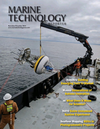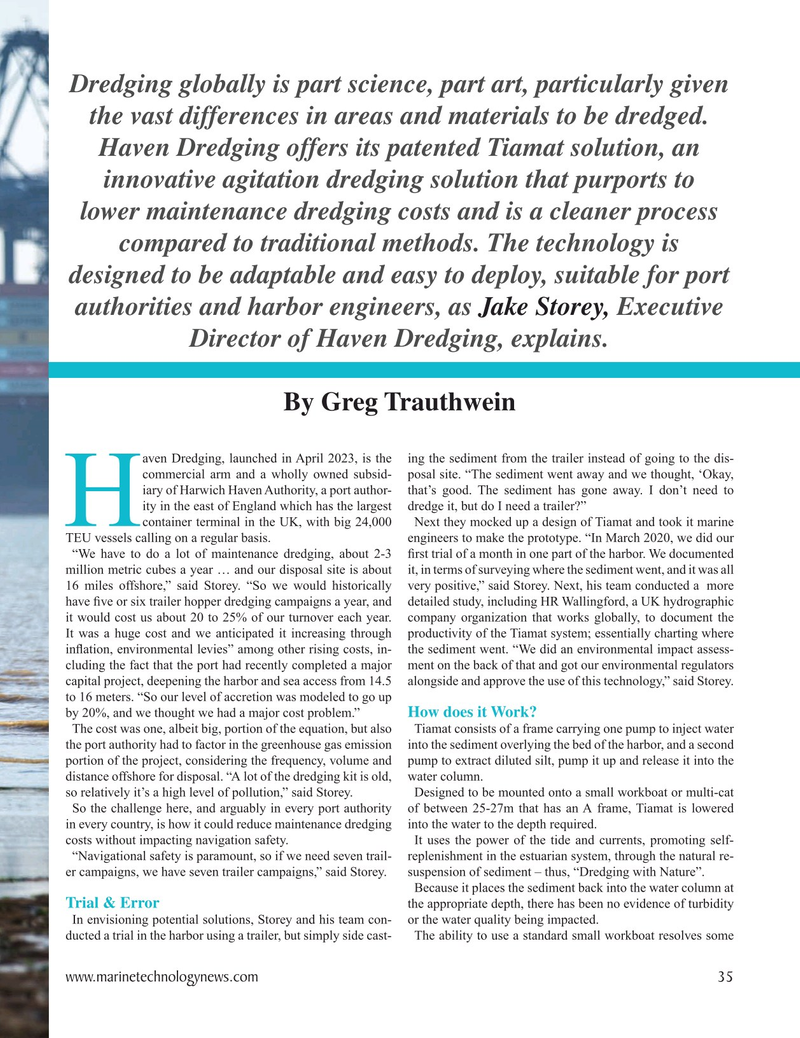
Page 35: of Marine Technology Magazine (November 2023)
Read this page in Pdf, Flash or Html5 edition of November 2023 Marine Technology Magazine
Dredging globally is part science, part art, particularly given the vast differences in areas and materials to be dredged.
Haven Dredging offers its patented Tiamat solution, an innovative agitation dredging solution that purports to lower maintenance dredging costs and is a cleaner process compared to traditional methods. The technology is designed to be adaptable and easy to deploy, suitable for port authorities and harbor engineers, as Jake Storey, Executive
Director of Haven Dredging, explains.
By Greg Trauthwein aven Dredging, launched in April 2023, is the ing the sediment from the trailer instead of going to the dis- commercial arm and a wholly owned subsid- posal site. “The sediment went away and we thought, ‘Okay, iary of Harwich Haven Authority, a port author- that’s good. The sediment has gone away. I don’t need to ity in the east of England which has the largest dredge it, but do I need a trailer?”
Hcontainer terminal in the UK, with big 24,000 Next they mocked up a design of Tiamat and took it marine
TEU vessels calling on a regular basis. engineers to make the prototype. “In March 2020, we did our “We have to do a lot of maintenance dredging, about 2-3 ? rst trial of a month in one part of the harbor. We documented million metric cubes a year … and our disposal site is about it, in terms of surveying where the sediment went, and it was all 16 miles offshore,” said Storey. “So we would historically very positive,” said Storey. Next, his team conducted a more have ? ve or six trailer hopper dredging campaigns a year, and detailed study, including HR Wallingford, a UK hydrographic it would cost us about 20 to 25% of our turnover each year. company organization that works globally, to document the
It was a huge cost and we anticipated it increasing through productivity of the Tiamat system; essentially charting where in? ation, environmental levies” among other rising costs, in- the sediment went. “We did an environmental impact assess- cluding the fact that the port had recently completed a major ment on the back of that and got our environmental regulators capital project, deepening the harbor and sea access from 14.5 alongside and approve the use of this technology,” said Storey.
to 16 meters. “So our level of accretion was modeled to go up
How does it Work?
by 20%, and we thought we had a major cost problem.”
The cost was one, albeit big, portion of the equation, but also Tiamat consists of a frame carrying one pump to inject water the port authority had to factor in the greenhouse gas emission into the sediment overlying the bed of the harbor, and a second portion of the project, considering the frequency, volume and pump to extract diluted silt, pump it up and release it into the distance offshore for disposal. “A lot of the dredging kit is old, water column.
so relatively it’s a high level of pollution,” said Storey. Designed to be mounted onto a small workboat or multi-cat
So the challenge here, and arguably in every port authority of between 25-27m that has an A frame, Tiamat is lowered in every country, is how it could reduce maintenance dredging into the water to the depth required.
costs without impacting navigation safety. It uses the power of the tide and currents, promoting self- “Navigational safety is paramount, so if we need seven trail- replenishment in the estuarian system, through the natural re- er campaigns, we have seven trailer campaigns,” said Storey. suspension of sediment – thus, “Dredging with Nature”.
Because it places the sediment back into the water column at
Trial & Error the appropriate depth, there has been no evidence of turbidity
In envisioning potential solutions, Storey and his team con- or the water quality being impacted.
ducted a trial in the harbor using a trailer, but simply side cast- The ability to use a standard small workboat resolves some www.marinetechnologynews.com 35
MTR #8 (34-47).indd 35 11/28/2023 9:55:24 AM

 34
34

 36
36
